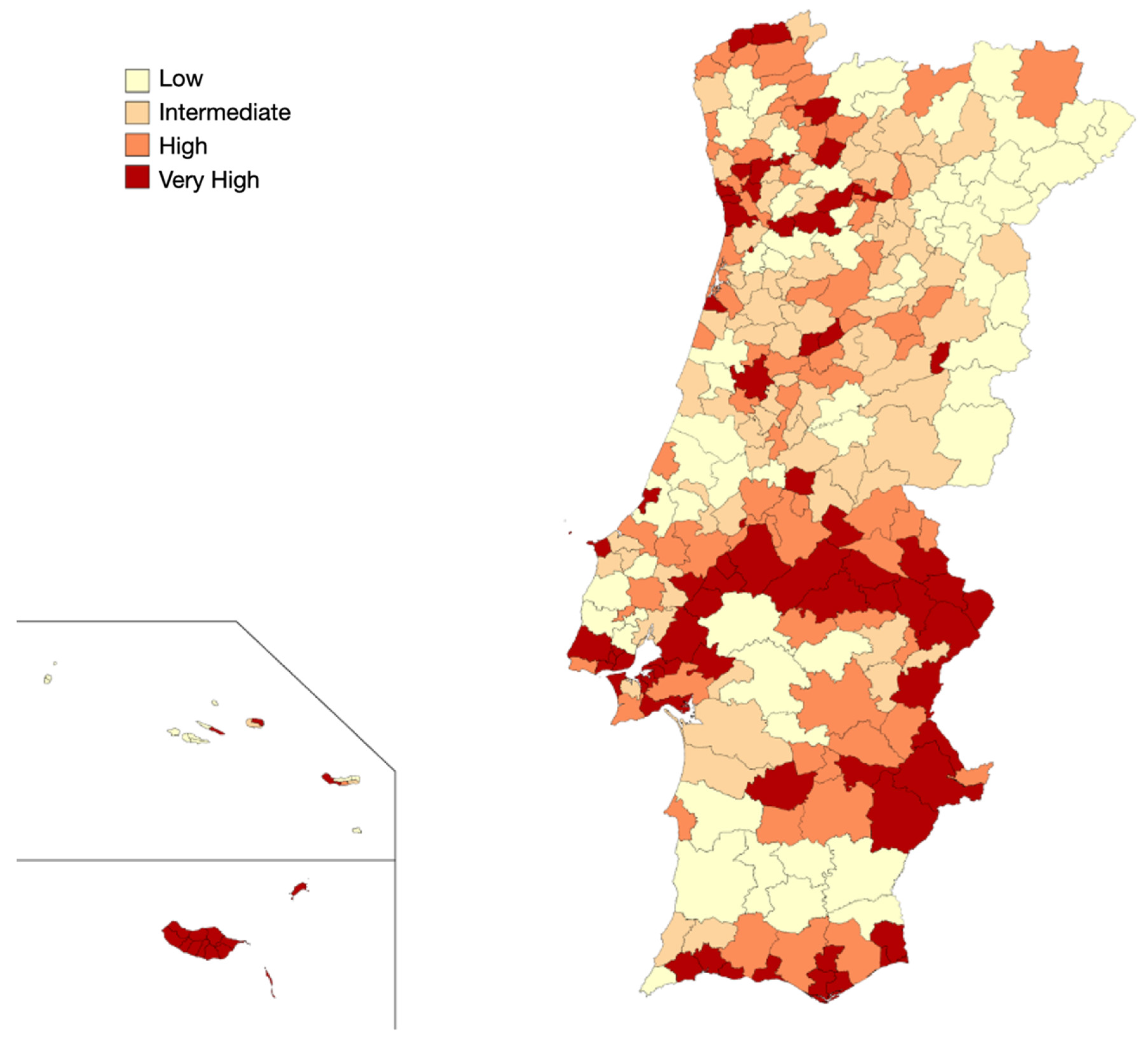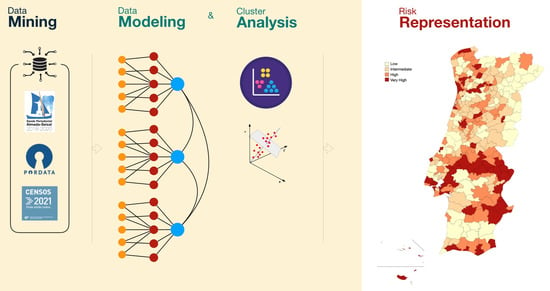Geographical Distribution of Periodontitis Risk and Prevalence in Portugal Using Multivariable Data Mining and Modeling
Abstract
1. Introduction
2. Materials and Methods
2.1. Study Area
2.2. Variables
2.3. Sample Size
2.4. Statistical Analysis
3. Results
3.1. Model Development
3.2. Periodontitis Risk and Prevalence Estimation
4. Discussion
5. Conclusions
Supplementary Materials
Author Contributions
Funding
Institutional Review Board Statement
Informed Consent Statement
Data Availability Statement
Conflicts of Interest
References
- Hajishengallis, G.; Lamont, R.J. Polymicrobial Communities in Periodontal Disease: Their Quasi-organismal Nature and Dialogue with the Host. Periodontol. 2000 2021, 86, 210–230. [Google Scholar] [CrossRef] [PubMed]
- Kinane, D.F.; Stathopoulou, P.G.; Papapanou, P.N. Periodontal Diseases. Nat. Rev. Dis. Prim. 2017, 3, 17038. [Google Scholar] [CrossRef] [PubMed]
- Tonetti, M.S.; Greenwell, H.; Kornman, K.S. Staging and Grading of Periodontitis: Framework and Proposal of a New Classification and Case Definition. J. Clin. Periodontol. 2018, 45, S149–S161. [Google Scholar] [CrossRef]
- Carvalho, R.; Botelho, J.; Machado, V.; Mascarenhas, P.; Alcoforado, G.; Mendes, J.J.; Chambrone, L. Predictors of Tooth Loss during Long-term Periodontal Maintenance: An Updated Systematic Review. J. Clin. Periodontol. 2021, 48, 1019–1036. [Google Scholar] [CrossRef]
- Buset, S.L.; Walter, C.; Friedmann, A.; Weiger, R.; Borgnakke, W.S.; Zitzmann, N.U. Are Periodontal Diseases Really Silent? A Systematic Review of Their Effect on Quality of Life. J. Clin. Periodontol. 2016, 43, 333–344. [Google Scholar] [CrossRef] [PubMed]
- Ferreira, M.C.; Dias-Pereira, A.C.; Branco-de-Almeida, L.S.; Martins, C.C.; Paiva, S.M. Impact of Periodontal Disease on Quality of Life: A Systematic Review. J. Periodontal Res. 2017, 52, 651–665. [Google Scholar] [CrossRef]
- Botelho, J.; Machado, V.; Leira, Y.; Proença, L.; Chambrone, L.; Mendes, J.J. Economic Burden of Periodontitis in the United States and Europe: An Updated Estimation. J. Periodontol. 2022, 93, 373–379. [Google Scholar] [CrossRef]
- Kassebaum, N.J.; Bernabé, E.; Dahiya, M.; Bhandari, B.; Murray, C.J.L.; Marcenes, W. Global Burden of Severe Periodontitis in 1990–2010: A Systematic Review and Meta-Regression. J. Dent. Res. 2014, 93, 1045–1053. [Google Scholar] [CrossRef]
- Marcenes, W.; Kassebaum, N.J.; Bernabé, E.; Flaxman, A.; Naghavi, M.; Lopez, A.; Murray, C.J.L. Global Burden of Oral Conditions in 1990–2010: A Systematic Analysis. J. Dent. Res. 2013, 92, 592–597. [Google Scholar] [CrossRef]
- Wu, L.; Zhang, S.; Zhao, L.; Ren, Z.; Hu, C. Global, Regional and National Burden of Periodontitis from 1990 to 2019: Results from the Global Burden of Disease Study 2019. J. Periodontol. 2022; ahead of print. [Google Scholar] [CrossRef]
- Direção Geral da Saúde. III Estudo de Prevalência Das Doenças Orais; Direção Geral de Saúde: Lisbon, Protugal, 2015.
- Botelho, J.; Machado, V.; Proença, L.; Alves, R.; Cavacas, M.A.; Amaro, L.; Mendes, J.J. Study of Periodontal Health in Almada-Seixal (SoPHiAS): A Cross-Sectional Study in the Lisbon Metropolitan Area. Sci. Rep. 2019, 9, 15538. [Google Scholar] [CrossRef]
- Aimetti, M.; Perotto, S.; Castiglione, A.; Mariani, G.M.; Ferrarotti, F.; Romano, F. Prevalence of Periodontitis in an Adult Population from an Urban Area in North Italy: Findings from a Cross-Sectional Population-Based Epidemiological Survey. J. Clin. Periodontol. 2015, 42, 622–631. [Google Scholar] [CrossRef]
- Bourgeois, D.; Bouchard, P.; Mattout, C. Epidemiology of Periodontal Status in Dentate Adults in France, 2002–2003. J. Periodontal Res. 2007, 42, 219–227. [Google Scholar] [CrossRef] [PubMed]
- Carasol, M.; Llodra, J.C.; Fernández-Meseguer, A.; Bravo, M.; García-Margallo, M.T.; Calvo-Bonacho, E.; Sanz, M.; Herrera, D. Periodontal Conditions among Employed Adults in Spain. J. Clin. Periodontol. 2016, 43, 548–556. [Google Scholar] [CrossRef] [PubMed]
- Holde, G.E.; Oscarson, N.; Trovik, T.A.; Tillberg, A.; Jönsson, B. Periodontitis Prevalence and Severity in Adults: A Cross-Sectional Study in Norwegian Circumpolar Communities. J. Periodontol. 2017, 88, 1012–1022. [Google Scholar] [CrossRef] [PubMed]
- Holtfreter, B.; Schwahn, C.; Biffar, R.; Kocher, T. Epidemiology of Periodontal Diseases in the Study of Health in Pomerania. J. Clin. Periodontol. 2009, 36, 114–123. [Google Scholar] [CrossRef]
- Schützhold, S.; Kocher, T.; Biffar, R.; Hoffmann, T.; Schmidt, C.O.; Micheelis, W.; Jordan, R.; Holtfreter, B. Changes in Prevalence of Periodontitis in Two German Population-Based Studies. J. Clin. Periodontol. 2015, 42, 121–130. [Google Scholar] [CrossRef]
- Wu, C.; Yuan, Y.; Liu, H.; Li, S.; Zhang, B.; Chen, W.; An, Z.; Chen, S.; Wu, Y.; Han, B.; et al. Epidemiologic Relationship between Periodontitis and Type 2 Diabetes Mellitus. BMC Oral Health 2020, 20, 204. [Google Scholar] [CrossRef]
- Muñoz Aguilera, E.; Suvan, J.; Buti, J.; Czesnikiewicz-Guzik, M.; Barbosa Ribeiro, A.; Orlandi, M.; Guzik, T.J.; Hingorani, A.D.; Nart, J.; D’Aiuto, F. Periodontitis Is Associated with Hypertension: A Systematic Review and Meta-Analysis. Cardiovasc. Res. 2020, 116, 28–39. [Google Scholar] [CrossRef]
- Machado, V.; Lopes, J.; Patrão, M.; Botelho, J.; Proença, L.; Mendes, J.J. Validity of the Association between Periodontitis and Female Infertility Conditions: A Concise Review. Reproduction 2020, 160, R41–R54. [Google Scholar] [CrossRef]
- Pihlstrom, B.L.; Michalowicz, B.S.; Johnson, N.W. Periodontal Diseases. Lancet 2005, 366, 1809–1820. [Google Scholar] [CrossRef]
- Relvas, M.; López-Jarana, P.; Monteiro, L.; Pacheco, J.J.; Braga, A.C.; Salazar, F. Study of Prevalence, Severity and Risk Factors of Periodontal Disease in a Portuguese Population. J. Clin. Med. 2022, 11, 3728. [Google Scholar] [CrossRef] [PubMed]
- Machado, V.; Botelho, J.; Amaral, A.; Proença, L.; Alves, R.; Rua, J.; Cavacas, M.A.; Delgado, A.S.; Mendes, J.J. Prevalence and Extent of Chronic Periodontitis and Its Risk Factors in a Portuguese Subpopulation: A Retrospective Cross-Sectional Study and Analysis of Clinical Attachment Loss. PeerJ 2018, 6, e5258. [Google Scholar] [CrossRef]
- Albuquerque, C.; Machado, B.; Albuquerque, C. Oral Health in Portugal: Small Steps in the Right Direction. Dent. Oral Biol. Craniofacial Res. 2019, 2, 2613–4950. [Google Scholar] [CrossRef]
- Dye, B.A.; Thornton-Evans, G. A Brief History of National Surveillance Efforts for Periodontal Disease in the United States. J. Periodontol. 2007, 78, 1373–1379. [Google Scholar] [CrossRef] [PubMed]
- Albandar, J.M.; Rams, T.E. Global Epidemiology of Periodontal Diseases: An Overview. Periodontol. 2000 2002, 29, 7–10. [Google Scholar] [CrossRef] [PubMed]
- Rose, G.; Khaw, K.-T.; Marmot, M. Rose’s Strategy of Preventive Medicine, 1st ed.; Oxford University Press: Oxford, UK, 2008; ISBN 9780192630971. [Google Scholar]

| Cluster | Sociodemographic Characteristics | N | Municipalities |
|---|---|---|---|
| 1 | mainly rural/low populated, including small villages | 143 | (*) |
| 2 | partly rural/including small cities | 104 | (*) |
| 3 | partly rural/including small to medium cities | 41 | (*) |
| 4 | mainly urban/peri-urban/including medium-sized to large cities | 8 | Leiria, Barcelos, S. Maria Feira, V. F. Xira, V. N. Famalicão, Maia, Setúbal, Funchal |
| 5 | mainly urban/peri-urban/including medium-sized to large cities | 8 | Guimarães, Loures, Braga, Seixal, Gondomar, Cascais, Almada, Matosinhos |
| 6 | urban/large city | 1 | Porto |
| 7 | peri-urban/large city | 1 | V. N. Gaia |
| 8 | urban/large city | 1 | Lisbon |
| 9 | peri-urban/large city | 1 | Sintra |
| Cluster | N | Average | Range (Min.–Max.) | Observations |
|---|---|---|---|---|
| 1 | 143 | 9.69 | 0.00–15.76 | - |
| 2 | 104 | 11.11 | 3.72–16.51 | - |
| 3 | 41 | 12.27 | 9.40–16.66 | - |
| 4 | 8 | 12.57 | 10.84–15.72 | - |
| 5 | 8 | 13.69 | 12.13–15.64 | - |
| 6 | 1 | 23.52 | - | Only one municipality (Porto) |
| 7 | 1 | 13.96 | - | Only one municipality (V. N. Gaia) |
| 8 | 1 | 25.11 | - | Only one municipality (Lisbon) |
| 9 | 1 | 10.81 | - | Only one municipality (Sintra) |
| Cluster | Municipalities | Population (n) | NUTS 1 | NUTS 2 | Estimated Periodontitis Prevalence (%) |
|---|---|---|---|---|---|
| 4 | Leiria | 128,640 | PT16 | PT16F | 41.4 |
| Barcelos | 116,777 | PT11 | PT112 | 41.6 | |
| S. Maria Feira | 136,720 | PT11 | PT11A | 46.7 | |
| V. F. Xira | 164,255 | PT17 | PT170 | 47.5 | |
| V. N. Famalicão | 134,959 | PT11 | PT112 | 48.2 | |
| Maia | 134,959 | PT11 | PT11A | 57.1 | |
| Setúbal | 128,640 | PT17 | PT170 | 57.7 | |
| Funchal | 105,919 | PT30 | PT300 | 69.0 | |
| 5 | Guimarães | 164,255 | PT11 | PT119 | 48.7 |
| Loures | 201,646 | PT17 | PT170 | 53.3 | |
| Braga | 193,333 | PT11 | PT112 | 54.9 | |
| Seixal | 166,693 | PT17 | PT170 | 55.2 (*) | |
| Gondomar | 164,255 | PT11 | PT11A | 55.5 | |
| Cascais | 214,134 | PT17 | PT170 | 60.9 | |
| Almada | 177,400 | PT17 | PT170 | 63.3 (*) | |
| Matosinhos | 172,669 | PT11 | PT11A | 68.6 | |
| 7 | V. N. Gaia | 304,149 | PT11 | PT11A | 59.1 |
| 9 | Sintra | 385,954 | PT17 | PT170 | 41.2 |
Publisher’s Note: MDPI stays neutral with regard to jurisdictional claims in published maps and institutional affiliations. |
© 2022 by the authors. Licensee MDPI, Basel, Switzerland. This article is an open access article distributed under the terms and conditions of the Creative Commons Attribution (CC BY) license (https://creativecommons.org/licenses/by/4.0/).
Share and Cite
Antunes, A.; Botelho, J.; Mendes, J.J.; Delgado, A.S.; Machado, V.; Proença, L. Geographical Distribution of Periodontitis Risk and Prevalence in Portugal Using Multivariable Data Mining and Modeling. Int. J. Environ. Res. Public Health 2022, 19, 13634. https://doi.org/10.3390/ijerph192013634
Antunes A, Botelho J, Mendes JJ, Delgado AS, Machado V, Proença L. Geographical Distribution of Periodontitis Risk and Prevalence in Portugal Using Multivariable Data Mining and Modeling. International Journal of Environmental Research and Public Health. 2022; 19(20):13634. https://doi.org/10.3390/ijerph192013634
Chicago/Turabian StyleAntunes, Ana, João Botelho, José João Mendes, Ana Sintra Delgado, Vanessa Machado, and Luís Proença. 2022. "Geographical Distribution of Periodontitis Risk and Prevalence in Portugal Using Multivariable Data Mining and Modeling" International Journal of Environmental Research and Public Health 19, no. 20: 13634. https://doi.org/10.3390/ijerph192013634
APA StyleAntunes, A., Botelho, J., Mendes, J. J., Delgado, A. S., Machado, V., & Proença, L. (2022). Geographical Distribution of Periodontitis Risk and Prevalence in Portugal Using Multivariable Data Mining and Modeling. International Journal of Environmental Research and Public Health, 19(20), 13634. https://doi.org/10.3390/ijerph192013634












